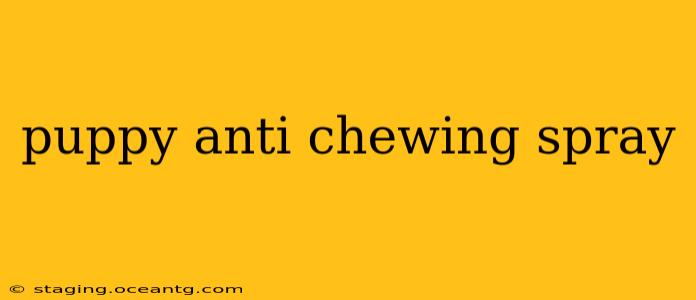Bringing home a new puppy is an exciting time, filled with playful cuddles and adorable antics. However, puppies are notorious for their chewing habits, which can quickly turn a joyous occasion into a frustrating experience. Damaged furniture, chewed shoes, and electrical cords pose significant risks. Fortunately, puppy anti-chewing sprays can be a valuable tool in training your furry friend and protecting your belongings. This comprehensive guide delves into the world of puppy anti-chewing sprays, addressing common questions and concerns.
What is Puppy Anti-Chewing Spray?
Puppy anti-chewing sprays are specifically formulated deterrents designed to discourage chewing behavior in puppies. These sprays typically contain bitter-tasting ingredients that are safe for dogs but unpleasant enough to make them avoid the treated surfaces. The goal is not to punish the puppy, but to redirect their chewing habits to more appropriate outlets. Many sprays utilize natural ingredients, appealing to owners seeking eco-friendly solutions.
How Does Puppy Anti-Chewing Spray Work?
The effectiveness of these sprays relies on the unpleasant taste they deliver. When a puppy chews on a treated item, the bitter taste acts as a negative reinforcement, associating the object with an undesirable experience. This helps them learn to avoid chewing on those particular items. Consistency is key; repeated exposure to the bitter taste helps solidify the learning process. Remember, this isn't a magic bullet; it's most effective when paired with positive reinforcement training methods.
What are the Best Ingredients in Puppy Anti-Chewing Spray?
Many effective sprays utilize natural, pet-safe ingredients. Look for sprays that list these ingredients prominently:
- Bitter Apple Extract: This is a common and generally safe ingredient found in many commercial sprays. It provides a strong, unpleasant taste without being toxic.
- Grapefruit Seed Extract: This natural extract offers a bitter taste and also has some mild antiseptic properties.
- Peppermint Oil: While generally safe for dogs in diluted form, peppermint oil should be used cautiously and in sprays specifically formulated for pets. Always check the label.
Is Puppy Anti-Chewing Spray Safe for My Puppy?
The safety of the spray is paramount. Always choose sprays explicitly labeled as "safe for puppies" or "non-toxic." Read the ingredient list carefully and avoid sprays containing harmful chemicals or essential oils that could be toxic if ingested. If you have any concerns, consult your veterinarian before using any anti-chewing spray.
How Often Should I Use Puppy Anti-Chewing Spray?
The frequency of application depends on the spray and your puppy's chewing habits. Some sprays need to be reapplied daily, while others may last longer. Always follow the manufacturer's instructions on the label. Reapply after cleaning or if the spray's effectiveness seems to diminish.
What are Some Alternatives to Anti-Chewing Spray?
While anti-chewing spray can be a helpful tool, it's essential to combine it with other training methods for the best results. Consider these alternatives:
- Providing Plenty of Chew Toys: Offer a variety of safe and appropriate chew toys to satisfy your puppy's natural chewing instincts.
- Positive Reinforcement Training: Reward your puppy with treats and praise when they choose to chew on their toys instead of your belongings.
- Puppy-Proofing Your Home: Remove tempting items from your puppy's reach to minimize the opportunity for chewing.
Can Anti-Chewing Spray Damage Furniture?
Reputable anti-chewing sprays are formulated to be safe for most surfaces. However, it's always advisable to test the spray on an inconspicuous area first to ensure it doesn't stain or damage the material. Follow the manufacturer’s instructions for application and usage.
Where Can I Buy Puppy Anti-Chewing Spray?
Puppy anti-chewing sprays are readily available at pet stores, both online and in physical locations. You can also find them at many major retailers.
By understanding how these sprays work, choosing safe products, and combining them with positive training methods, you can create a safe and happy environment for both you and your puppy. Remember, patience and consistency are key to successful puppy training.
